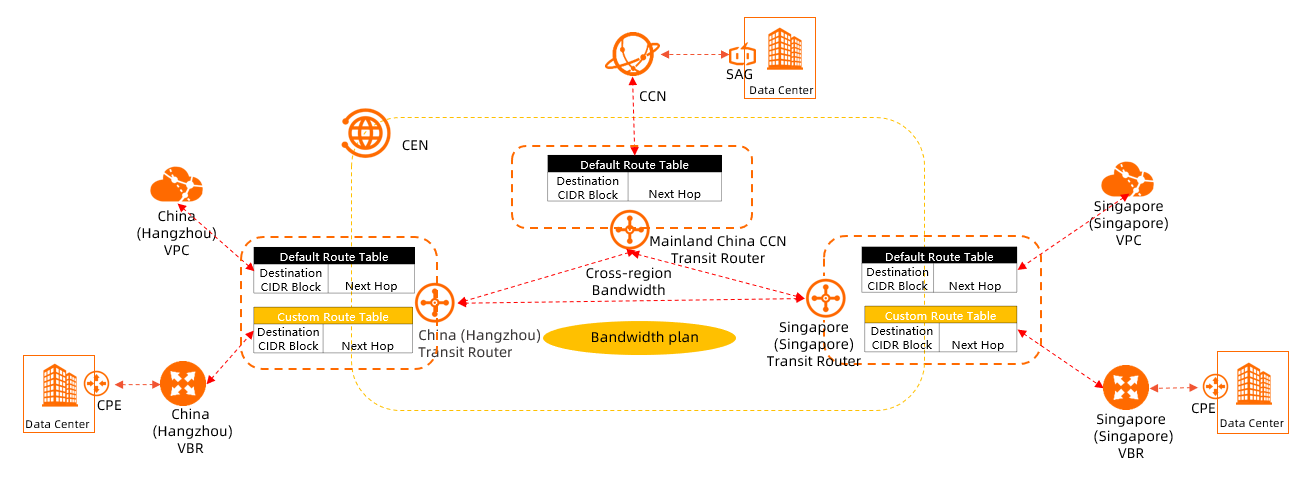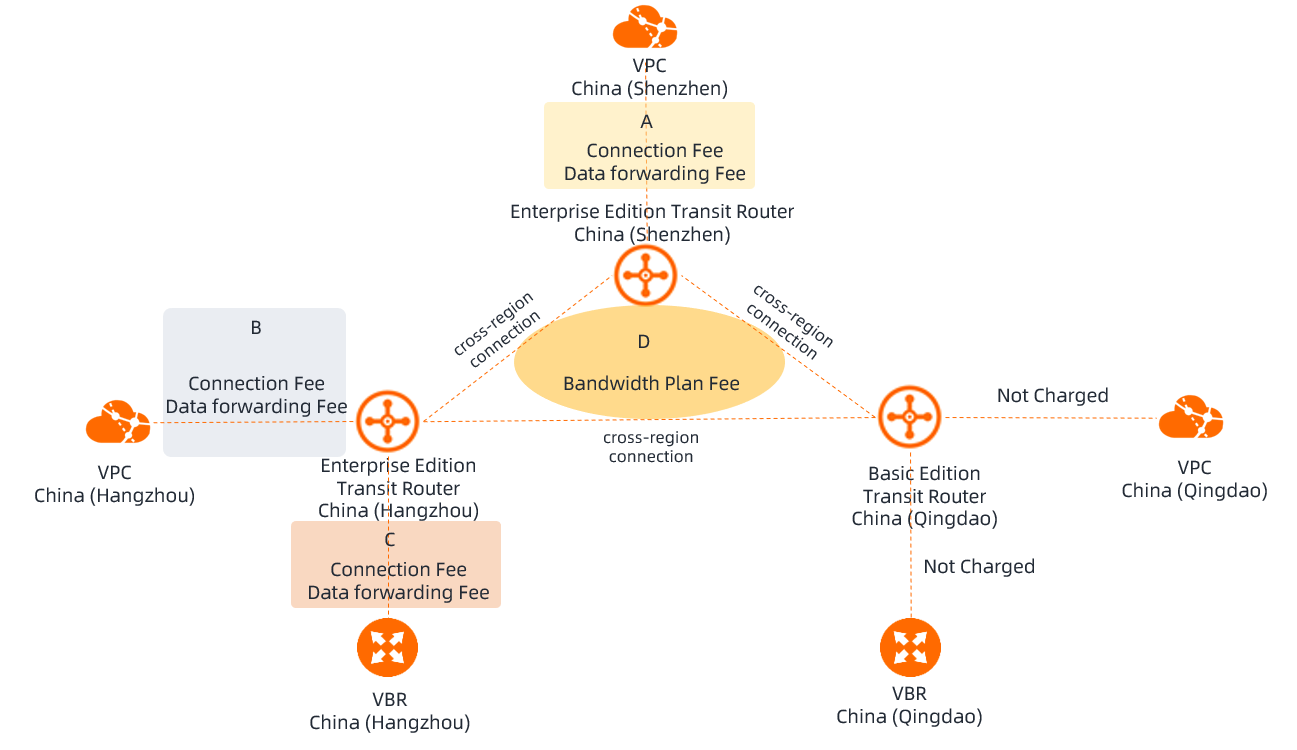By: Jeremy Pedersen
This week, we take a dive into Cloud Enterprise Network (CEN) billing.
Cloud Enterprise Network is a tool for routing between private networks on Alibaba Cloud, allowing users to seamlessly connect VPC network groups.
The connections made over CEN are always private, meaning they pass over Alibaba Cloud's own network backbone, rather than the public Internet.
Within a single Region, CEN traffic is free of charge. Not surprisingly, traffic between Regions is not free, because inter-region private bandwidth is a scarce commodity!
Adding to this, CEN depends on Transit Routers (TRs) to push traffic around, and there are two different versions of TR, one of which charges additional fees on top of the bandwidth charges for inter-region connections.
Confused yet? You aren't the only one! Let's dive in and answer some important questions, including:
Luckily, the CEN documentation has a billing page that breaks all the costs down.
Unluckily, that page is not an easy read! Let's break down the different billable items and consider how they interact.
We'll start with a hypothetical network diagram, shamelessly borrowed from the documentation, of course:

Here you can see the major components of the CEN. The yellow dotted "box" at the center of the diagram is the CEN instance itself.
Essentially, this is a route table which keeps track of the networks that are attached to CEN and figures out how traffic should be routed between them.
This component - the CEN instance - is always free.
So where do the costs come from? One important "cost center" is CEN's Transit Routers (TRs). There are two version of TR:
Basic Edition doesn't charge any additional fees, but Enterprise Edition charges for two things:
The third cost comes from connections between regions. Routing traffic from one region to another requires that users purchase a bandwidth package.
Bandwidth packages are not explicitly tied to a particular Region. Instead, each package covers a geographical area that could contain multiple Alibaba Cloud Regions.
Example: A bandwidth package for "Mainland China <-> North America" could cover a connection from the Shanghai region to US East, and at the same time also cover a CEN connection from Beijing to US West (Silicon Valley). You can split bandwidth packages up, using a single package to cover multiple region-to-region connections.
Let's put it all together (again, shamelessly borrowing from the official documentation here):

Can you guess how many things we need to pay for in this scenario? Here's the full list:
"But wait!", I can already hear you asking, "what happened to Qingdao?". Because Qingdao is using a Basic Edition Transit Router, there are no connection or data forwarding costs.
There's a full rundown of the differences between transit router types here. Essentially, it boils down to this:
Bottom Line: If all you need is basic inter-region networking, then Basic Edition TRs will work fine for you!
Let's just summarize all of this one more time to make sure it's as clear as possible:
Whew, that's everything!
We now need to work out the exact costs for the three major CEN components:
Below, I summarize these costs at the time of writing (2022-04-21).
Note that the prices below can change at any time. The prices below were what was listed on the CEN console's purchase page on 2022-04-21.
These costs are for a 2 Mbps connection (prices vary based on connection bandwidth, and bandwidth can vary from 2 Mbps up to more than 1 Gbps).
There's a flat data transfer fee for traffic into any Enterprise TR, in any region: 0.02 USD / GB.
There are two general "classes" of connection fee:
Assume we need a point-to-point connection from a VPC in Shanghai China, to another VPC in Tokyo.
We will consider two possibilities: one in which we need custom routes (Enterprise TR) and one in which we do not (Basic TR).
In the case where we don't need Enterprise Edition TR, we have only a single cost: bandwidth.
We will need a Mainland China <-> Asia Pacific bandwidth package.
Let's assume we need 2 Mbps for a month. The monthly cost is 264.00 USD / month, as specified earlier in this blog post.
Total Monthly Cost: 264.00 USD.
That's it! Pretty easy to figure out, right?
With Enterprise TR, we will still have the fixed cost of 264.00 USD / month for the bandwidth package, but we also have to worry about the connection and bandwidth costs for our two Enterprise Edition TRs (one in Tokyo and one in Shanghai), each of which is connected to a single VPC.
We also have data transfer costs to consider. We will assume "maximum utilization": 1 Mbps of traffic constantly flowing from Tokyo -> Shanghai, and another 1 Mbps of traffic from Shanghai -> Tokyo (so our 2 Mbps bandwidth package is fully utilized at all times).
Note that 1 Mbps is about 450 MB / hour. This works out to about 324,000 MB per month, which is approximately 316 GB.
Adding it all up: 6.32 x 2 + 43.20 + 36.00 + 264.00 = 355.84 USD
Total Monthly Cost: 355.84 USD
We can see here that using Enterprise Edition TRs is about 1.35x more expensive than using Basic Edition TRs. The difference will grow more noticeable as more connections are made to each TR, as well.
What if we used VPN Gateway instead? We will start with the following assumptions:
In this case, we'll have the following costs:
Further assumptions:
Adding it all up: 0.059 USD/hour x 720 hours + 0.091 USD/hour x 720 hours + 0.125 USD/GB/hour x 0.44 GB/hour x 720 hours + 0.120 USD/GB/hour x 0.44 GB/hour x 720 hours = 185.62
Total Monthly Cost: 185.62 USD
This is a lot cheaper than CEN!
We could go a lot deeper into it, but that'll do for this week! See you next time. ^_^
Great! Reach out to me at jierui.pjr@alibabacloud.com and I'll do my best to answer in a future Friday Q&A blog.
You can also follow the Alibaba Cloud Academy LinkedIn Page. We'll re-post these blogs there each Friday.
A Tangled Web: Advanced Networking on Alibaba Cloud - Friday Blog, Week 58
Alibaba Cloud Community - April 22, 2022
JDP - February 10, 2022
JDP - June 4, 2021
JDP - March 17, 2022
JDP - November 19, 2021
JDP - October 15, 2021
 Accelerated Global Networking Solution for Distance Learning
Accelerated Global Networking Solution for Distance Learning
Alibaba Cloud offers an accelerated global networking solution that makes distance learning just the same as in-class teaching.
Learn More Networking Overview
Networking Overview
Connect your business globally with our stable network anytime anywhere.
Learn More CEN
CEN
A global network for rapidly building a distributed business system and hybrid cloud to help users create a network with enterprise level-scalability and the communication capabilities of a cloud network
Learn More Edge Network Acceleration
Edge Network Acceleration
Establish high-speed dedicated networks for enterprises quickly
Learn MoreMore Posts by JDP
Osama Hafez April 22, 2022 at 10:16 pm
Thanks